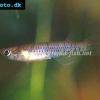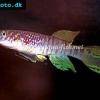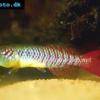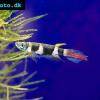Panchax - Epiplatys esekanus
Scientific name: Epiplatys esekanus
Common name: Panchax
Family: Nothobranchiidae
Usual size in fish tanks: 6 - 7 cm (2.36 - 2.76 inch)
014
Recommended pH range: 5 - 6.5
Recommended water hardness: 0 - 12°N (0 - 214.29ppm)
0°C 32°F30°C 86°F
Recommended temperature range: 20 - 24 °C (68 - 75.2°F)
The way how these fish reproduce: Spawning
Where the species comes from: Africa
Temperament to its own species: peaceful
Temperament toward other fish species: aggressive to smaller
Usual place in the tank: Middle levels
Origin
These fish inhabits the waterways on the African continent, they are generally accepted to be endemic to the country of Cameroon but recently populations have been discovered further afield.
Short description
Epiplatys esekanus are quite common in the aquarium trade and belong to the family of Nothobranchiidae along with many of their close relatives. Adult specimens will reach an average size of up to 2.3 - 2.6 inches in the aquarium with wild specimens being slightly larger. This makes them ideal for smaller to medium aquariums but they do require the highest of water conditions. Mature males are more colourful compared to male females but they all make for a great addition to the aquarium, it should be noted however that they will see smaller tank mates as a food source so should only be housed with species of a similar size.
Lifespan
If cared for correctly, the average lifespan for Epiplatys esekanusshould be between 1-2 years!
General care
The minimum sized aquarium that should be used to house these fish should be capable of holding at least 20 gallons in water volume. Always use a filtration system that is rated for the volume and fit a tight fitting lid as these fish can be excellent jumpers. The water temperature should range between 20- 24°C (68-75°F) and the pH should range between 5.0-6.5. They are quite an easy species to care for but they do demand a high water quality so regular water changes should be performed. The choice of substrate is yours but they do prefer a planted setup with the addition of some floating plants. They tend to occupy the higher levels and floating plants will give them some cover and hiding places. The lighting levels should be moderate. On;y keep these fish with species of a similar size or slightly larger as they will see smaller species as a target for aggression.
Feeding
Epiplatys esekanus are not difficult to feed and they will settle into the aquarium quickly accepting all foods that are offered. Use a quality flake for the staple diet but vary this with treats of live or frozen foods such as brine shrimp or blood worms. It is best to feed these fish twice a day with smaller meals rather than one large meal a day.
Sexing
Mature females tend to develop smaller than mature males, they will also have a duller colouration. The males will display a golden colouration on their bodies which is broken by red spots. The females lack the spots but they may develop stripes towards the rear of their bodies!
Breeding
Like all of the panchax species Epiplatys esekanus are egg scatterers and these are usually spread amongst any foliage in the aquarium. It is not difficult to get them to spawn but for optimum success it is best to use a separate planted breeding tank, spawning mops can also be used if desired. The female will deposit small batches of eggs which are quickly fertilised by the male. This process will be repeated over a period of days rather than in one session. If using spawning mops these can be removed from the breeding tank on a daily basis and the mops replaced with new ones. The mops with eggs can be housed in another small tank. To control water flow use an air driven sponge filter and keep the lighting dimmed.
The eggs should hatch after two weeks, dependant on the water temperature and once free swimming they can be fed on newly hatched brine shrimp or a commercial egg layer fry food. Larger fry may prey on the smaller ones so you may need to size grade and separate them as they develop.

 Lyretail
Lyretail  Splendid
Splendid  Redchin
Redchin  Sixbar
Sixbar  Amiets
Amiets  Blue
Blue  Blue
Blue  Guenthers
Guenthers  Banded
Banded